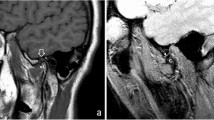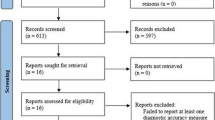Abstract
Objective
To determine the prevalence of the elongated styloid process (ESP) and its characteristics, such as sex and age of the patient, unilateral and bilateral incidence, besides variations between different populations and panoramic and CBCT examinations.
Materials and methods
A search was performed in six databases (PubMed, Web of Science, Scopus, Cochrane, Lilacs, and Embase) to identify observational studies that used imaging exams and assessed ESP prevalence among panoramic radiograph CBCT examinations, whose transversal prevalence studies were included. Furthermore, studies with a specific group of patients or symptomatic patients were excluded. Additionally, Joanna Briggs Institute checklist was used to evaluate the quality of the studies. A meta-analysis was conducted, then subgroup analyses were performed by grouping studies according to the secondary outcomes, with a significance level set at 5%. The Grading of Recommendations Assessment, Development, and Evaluation system was used to rate the certainty in the evidence.
Results
The initial search resulted in 1635 studies, from which 39 articles met the inclusion criteria, encompassing 50,655 participants. The sample size varied between 82 and 5,000 participants. The prevalence of the ESP ranged from 1.3 to 94.8%, with an overall prevalence of 30.2%. The bilateral occurrence was higher than the unilateral one, but no significant predilection was observed according to sex, age, or population. The type of imaging examination also showed no difference in its detection.
Conclusion
The overall prevalence of ESP was 30.2%, with a propensity for bilaterality, but not for any sex, age, or population geographic location. The imaging examination modality did not influence the diagnosis of ESP. However, the quality level of the studies evaluated was very low, demonstrating the need for more homogeneous primary studies on the prevalence of the ESP with a more standardized methodology.
Clinical relevance
There is no consensus in the literature regarding the prevalence of the ESP and the characteristics of the affected patients that can cause chronic and debilitating discomfort in the head and neck region. Therefore, knowledge about the prevalence and characteristics of this condition would help dental clinicians reach the correct diagnosis.




Similar content being viewed by others
References
Abdel-Ghany AF, Osman NM (2014) Role of three-dimensional multidetector computerized tomography in diagnosis of Eagle’s syndrome. Egypt J Radiol Nucl Med 45:105–108. https://doi.org/10.1016/j.ejrnm.2013.12.004
Carroll MKO (1984) Calcification in the stylohyoid ligament. Oral Surg Oral Med Oral Pathol 58:617–621. https://doi.org/10.1016/0030-4220(84)90089-6
Gokce C, Sisman Y, Ertas ET et al (2008) Prevalence of styloid process elongation on panoramic radiography in the Turkey population from Cappadocia region. Eur J Dent 02:18–22. https://doi.org/10.1055/s-0039-1697348
dos Lins CC, SA, Tavares RMC, Silva CC da, (2015) Use of digital panoramic radiographs in the study of styloid process elongation. Anat Res Int 2015:1–7. https://doi.org/10.1155/2015/474615
de Moraes EL, Soares MG, Maschtakow PSL et al (2009) Relação do tamanho do processo estilóide e sintomatologia dolorosa na região de cabeça e pescoço. Rev Assoc Paul Cir Dent 297–300
Alzarea BK (2017) Prevalence and pattern of the elongated styloid process among geriatric patients in Saudi Arabia. Clin Interv Aging 12:611–617. https://doi.org/10.2147/CIA.S129818
Rahman SA, bt Wan Hamizan AF, Takeuchi K et al (2018) Comparison between 2D and 3D measurement of styloid process length. J Hard Tissue Biol 27:51–54. https://doi.org/10.2485/jhtb.27.51
Higgins JPT, Thompson SG (2002) Quantifying heterogeneity in a meta-analysis. Stat Med 21:1539–1558. https://doi.org/10.1002/sim.1186
Higgins J, Green S (2011) Cochrane handbook for systematic reviews of interventions Version 5.1.0 [updated March 2011]. In: Cochrane Collab. www.handbook.cochrane.org
Alpoz E, Akar GC, Celik S et al (2014) Prevalence and pattern of stylohyoid chain complex patterns detected by panoramic radiographs among Turkish population. Surg Radiol Anat 36:39–46. https://doi.org/10.1007/s00276-013-1137-x
Bagga MB, Kumar CA, Yeluri G (2012) Clinicoradiologic evaluation of styloid process calcification. Imaging Sci Dent 42:155–161. https://doi.org/10.5624/isd.2012.42.3.155
Bruno G, de Stefani A, Balasso P et al (2017) Elongated styloid process: an epidemiological study on digital panoramic radiographs. J Clin Exp Dent 9:e1446–e1452. https://doi.org/10.4317/jced.54370
Buyuk C, Gunduz K, Avsever H (2018) Morphological assessment of the stylohyoid complex variations with cone beam computed tomography in a Turkish population. Folia Morphol 77:79–89. https://doi.org/10.5603/FM.a2017.0061
Correll RW, Jensen JL, Taylor JB, Rhyne RR (1979) Mineralization of the stylohyoid-stylomandibular ligament complex. A radiographic incidence study. Oral Surg Oral Med Oral Pathol 48:286–291. https://doi.org/10.1016/0030-4220(79)90025-2
Donmez M, Okumus O, Pekiner FN (2017) Cone beam computed tomographic evaluation of styloid process: a retrospective study of 1000 patients. Eur J Dent 11:210–215. https://doi.org/10.4103/ejd.ejd
Erol B (1996) Radiological assessment of elongated styloid process and ossified stylohyoid ligament. J Marmara Univ Dent Fac 2:554–556
Ferrario VF, Sigurta D, Daddona A et al (1990) Calcification of the stylohyoid ligament: Incidence and morphoquantitative evaluations. Oral Surg Oral Med Oral Pathol 69:524–529. https://doi.org/10.1016/0030-4220(90)90390-E
Gracco A, De SA, Bruno G et al (2017) Elongated styloid process evaluation on digital panoramic radiograph in a North Italian population. J Clin Exp Dent 9:e400–e404. https://doi.org/10.4317/jced.53450
Ledesma-Montes C, Hernández-Guerrero JC, Jiménez-Farfán MD (2018) Length of the ossified stylohyoid complex and Eagle syndrome. Eur Arch Oto-Rhino-Laryngol 275:2095–2100. https://doi.org/10.1007/s00405-018-5031-3
Luz JGC, Rodrigues L, Chilvarquer I, Soler JMP (2003) Mineralization of stylohyoid ligament complex in patients with temporomandibular disorders and asymptomatic individuals: A comparative study. J Oral Rehabil 30:909–913. https://doi.org/10.1046/j.1365-2842.2003.00933.x
MacDonald-Jankowski DS (2001) Calcification of the stylohyoid complex in Londoners and Hong Kong Chinese. Dentomaxillofac Radiol 30:35–39. https://doi.org/10.1038/sj.dmfr.4600574
Öztaş B, Orhan K (2012) Investigation of the incidence of stylohyoid ligament calcifications with panoramic radiographs. J Investig Clin Dent 3:30–35. https://doi.org/10.1111/j.2041-1626.2011.00081.x
Ribeiro A, Keat R, Khalid S et al (2018) Prevalence of calcifications in soft tissues visible on a dental pantomogram: a retrospective analysis. J Stomatol Oral Maxillofac Surg 119:369–374. https://doi.org/10.1016/j.jormas.2018.04.014
Roopashri G, Vaishali MR, David MP et al (2012) Evaluation of elongated styloid process on digital panoramic radiographs. J Contemp Dent Pract 13:618–622. https://doi.org/10.5005/jp-journals-10024-1197
Ruprecht A, Sastry KA, Gerard P, Mohammad AR (1988) Variation in the ossification of the stylohyoid process and ligament. Dentomaxillofac Radiol 17:61–66. https://doi.org/10.1259/dmfr.1988.0008
Safabakhsh M, Johari M, Bijani A, Haghanifar S (2018) Prevalence of soft tissue calcification in panoramic radiographs in northern of Iran. J Babol Univ Med Sci 20:41–45. https://doi.org/10.18869/acadpub.jbums.20.6.41
Togan B, Gander T, Lanzer M et al (2016) Incidence and frequency of nondental incidental findings on cone-beam computed tomography. J Cranio-Maxillofac Surg 44:1373–1380. https://doi.org/10.1016/j.jcms.2016.06.026
Vieira EMM, Guedes OA, De Morais S et al (2015) Prevalence of elongated styloid process in a central brazilian population. J Clin Diagn Res 9:90–92. https://doi.org/10.7860/JCDR/2015/14599.6567
Phulambrikar T, A R, Rao BB et al (2011) Incidence of elongated styloid process: a radiographic study. J Indian Acad Oral Med Radiol 23:S344–S346. https://doi.org/10.5005/jp-journals-10011-1165
Ilgüy M, Ilgüy D, Güler N, Bayirli G (2005) Incidence of the type and calcification patterns in patients with elongated styloid process. J Int Med Res 33:96–102. https://doi.org/10.1177/147323000503300110
Aoun G, Srour N, El-Outa A, Nasseh I (2020) Styloid process elongation in a sample of Lebanese population: a consideration for the prevention of Eagle syndrome. Med Pharm Reports 93:410–415. https://doi.org/10.15386/mpr-1666
Bagga MB, Bhatnagar D, Kumar N (2020) Elongated styloid process evaluation on digital panoramic radiographs: a retrospective study. J Indian Acad Oral Med Radiol 32:330–334. https://doi.org/10.4103/jiaomr.jiaomr_108_20
Ghassemzadeh S, Sbricoli L, Frigo AC, Bacci C (2021) Incidental findings detected with panoramic radiography: prevalence calculated on a sample of 2017 cases treated at a major Italian trauma and cancer centre. Oral Radiol 37:507–517. https://doi.org/10.1007/s11282-020-00488-1
Guimarães ACA, Pozza DH, Guimarães AS (2020) Prevalence of morphological and structural changes in the stylohyoid chain. J Clin Exp Dent 12:e1027–e1032. https://doi.org/10.4317/jced.57186
Meléndez-Rojas P, Arancibia-Mesas L, Poblete-Carrasco C (2020) Prevalence of soft tissue calcifications in CBCT images from the oral and maxillofacial radiology service at Unab, Viña del Mar, Chile. J Oral Res 9:451–459. https://doi.org/10.17126/joralres.2020.090
Saati S, Foroozandeh M, Alafchi B (2020) Radiographic characteristics of soft tissue calcification on digital panoramic images. Pesqui Bras Odontopediatria Clin Integr 20:1–9. https://doi.org/10.1590/pboci.2020.068
Shahidi S, Hasani M, Khozaei M (2021) Evaluating the relation between the elongated styloid process and the ponticulus posticus using cone beam computed tomography. Folia Morphol (Warsz). https://doi.org/10.5603/fm.a2021.0006
Garay I, Olate S (2013) Osificación del ligamento estilohioideo en 3.028 radiografías panorámicas digitales. Int J Morphol 31:31–37. https://doi.org/10.4067/S0717-95022013000100004
Gomes do Nascimento Junior W, Nascimento de Souza Pinto G, Vessoni Iwaki LC et al (2015) Prevalence of alterations of the stylohyoid complex in digital panoramic radiographs | Prevalencia de alteraciones en el complejo estilohiodeo en radiografías panorámicas digitales. Rev Cubana Estomatol 52:135–142
Calle-Velezmoro E, Palti-Menéndez LR, Agurto-Huerta A, Salazar-Fernández C (2014) Prevalencia de la mineralización de la cadena estilohioidea en radiografías panorámicas de pacientes mayores de 18 años. KIRU 11:9–12
Rubio C, Ganga H, Guzmán CL (2010) Análisis de la longitud del ligamento estilohiodeo mediante sistema cone beam. Rev CES Odontol 23:23–27
Castro-Espinoza E, Vidal-Dávila T, Barzallo-Sardi V et al (2020) Mineralización del complejo estilohioideo en una población de Cuenca-Ecuador. Rev Estomatológica Hered 30:139–144. https://doi.org/10.20453/reh.v30i3.3816
Guimarães AGP, Cury SEV, Silva MBF et al (2010) Prevalência do prolongamento do processo estilóide e/ou calcificação do ligamento estilo-hióideo em radiografias panorâmicas. RGORevista Gaúcha Odontol 58:481–485
Cavalcante IL, Barros CCDS, Prado JP et al (2018) Síndrome de Eagle: diagnóstico e incidência em uma população brasileira. Rev da Fac Odontol - UPF 22:288–293. https://doi.org/10.5335/rfo.v22i3.7563
Tavares H, de Freitas CF (2007) Prevalência do alongamento do processo estilóide do temporal e calcificação do ligamento estilo-hióideo, por meio da radiografia panorâmica. Radiologia 19:188–200
Palmier NR, Madrid CC, Martins BNFL et al (2018) Cracked tooth syndrome in irradiated patients with head and neck cancer. Oral Surg Oral Med Oral Pathol Oral Radiol 126:335–344
Coggon D, Geoffrey Rose, DJP Barker (1997) What is Epidemiology? In: Epidemiology for the uninitiated, Fourth. Wiley–Blackwell
Martins JNR, Marques D, Silva EJNL et al (2019) Prevalence studies on root canal anatomy using cone-beam computed tomographic imaging: a systematic review. J Endod 45:372-386.e4. https://doi.org/10.1016/j.joen.2018.12.016
Carroll MKO, Alpoz E, Akar GC et al (2018) Prevalence of calcifications in soft tissues visible on a dental pantomogram: a retrospective analysis. Oral Surg Oral Med Oral Pathol 9:188–200. https://doi.org/10.5005/jp-journals-10011-1165
Borges Migliavaca C, Stein C, Colpani V et al (2020) How are systematic reviews of prevalence conducted? A methodological study. BMC Med Res Methodol 20:1–9. https://doi.org/10.1186/s12874-020-00975-3
Funding
This study was financed in part by the Coordenação de Aperfeiçoamento de Pessoal de Nível Superior—Brasil (CAPES)—Finance Code 001.
Author information
Authors and Affiliations
Corresponding author
Ethics declarations
Ethical approval
Not applicable. This article does not contain any studies with human participants or animals performed by any of the authors.
Informed consent
For this type of study, formal consent is not required.
Conflict of interest
The authors declare no competing interests.
Additional information
Publisher's note
Springer Nature remains neutral with regard to jurisdictional claims in published maps and institutional affiliations.
Rights and permissions
About this article
Cite this article
Nogueira-Reis, F., de Oliveira Reis, L., Fontenele, R.C. et al. Prevalence and features of elongated styloid process on imaging studies: a systematic review and meta-analysis. Clin Oral Invest 26, 1199–1215 (2022). https://doi.org/10.1007/s00784-021-04285-w
Received:
Accepted:
Published:
Issue Date:
DOI: https://doi.org/10.1007/s00784-021-04285-w




